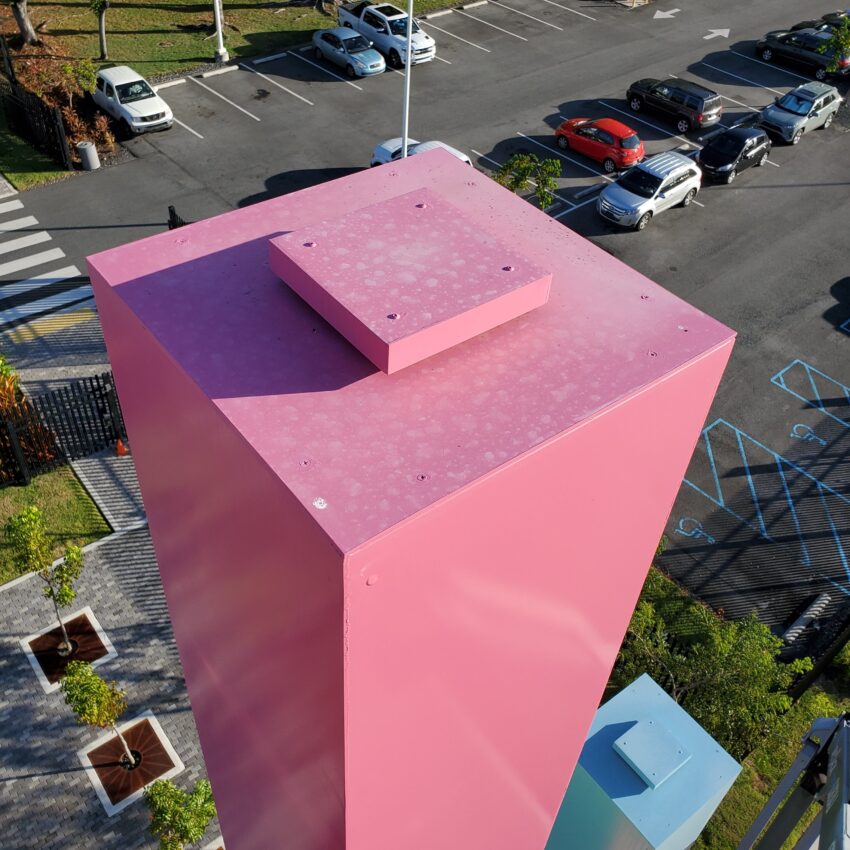The building blocks of any successful conservation treatment is to first perform a condition assessment. Jim Gwinner, Conservator of Public Art and Sculpture, of McKay Lodge Conservation Laboratory recently traveled perform a conservation assessment of painted sculpture in Puerto Rico.

The artwork Building Blocks, 2020 by Robert Behar and Rosario Marquardt was recently installed outside of the Federico Degetau Federal Building and Clemente Ruiz Nazario U.S. Courthouse in the Hato Rey Central barrio of San Juan, Puerto Rico.
Building Blocks is group of three square columns of various heights of 52, 38 and 26 feet. The columns are all the same dimension in width at 24 by 24 inches. All three of the columns have different and vibrantly colored sections in pastel pink, blue, green, and yellow which match the brightly colored nearby public squares.
The artwork is new, and it is in excellent condition. There are no major structural issues and only minor paint film defects. The overall surface had a light layer of settled dust. Slight streaking and run-offs were present on all of the columns; this is especially evident on the top of the columns where bird guano was found. And while bird guano isn’t always a bad thing, it is not good for outdoor artwork.

Streaking from water run-off and bird interaction with the sculpture can be very typical condition issues seen in outdoor sculpture conservation. These issues can be easily mitigated by regular cleaning maintenance, and in extreme examples, physical deterrents for birds.

It is not just birds; however, that sometimes take an interest in public artworks, but humans. While public art is meant for all to enjoy, sometimes this leads to both unintentional damage from touching and climbing to purposeful vandalism.

As Conservator Gwinner points out in his conservation assessment of the painted sculpture in Puerto Rico, Building Blocks appears to be landscaped with this in mind. Visitors can readily enjoy the sculpture as social gathering place, but the area directly around is hardscaped with pavers. Irrigation and vegetation which can cause moisture on the sculpture, and in turn, damage paint film and corrode the metal, are also free from the installation site.
Conservator Gwinner continued with his conservation assessment of the painted sculpture in Puerto Rico. He tested the dry film thickness (DFT) of the paint film, recording an average from dozens of representative samples. This information is important to note for a few reasons, including verifying if the paint was applied according to the manufacturer’s specifications and for future maintenance.

All coatings have a limited service life, and eventually the sculpture will need recoated. If the DFT is not too thick, the existing coating can be overcoated instead of being fully stripped. This is sometimes preferred when appropriate since overcoating can be more cost-effective and less invasive for the work of art.
Conservator Gwinner also observed some minor painting defects. This included disbonded areas of fill, and cracking and lifting in some areas of the paint. Most of the losses and cracking are superficial at this time, and they do not distract from the overall aesthetic of the artwork at a normal viewing distance. In the future, these areas will need to be addressed before they become areas of preferential corrosion. This is why regular conservation maintenance is important so that works of art are preserved as intended by the artist.

For now, Building Blocks stands as an outdoor place for social gathering and enjoyment. The columns unique and brightly colored sections are inspired by, as the artist’s plaque states, “the richness of life, vibrant colors and public squares of Puerto Rico….the sculpture could be interpreted as an abstract family portrait or the imagined skyline of the a new San Juan, where art and everyday life are one and the same”.

Robert Behar and Rosario Marquardt of R & R Studios have created other unique national and international public artworks. Selected projects can be viewed on their official site.
